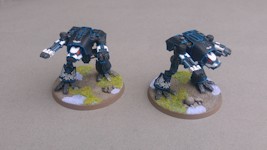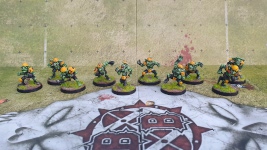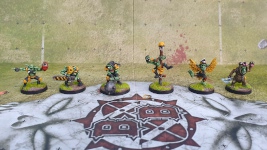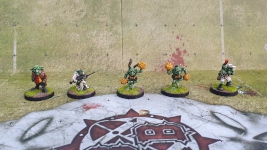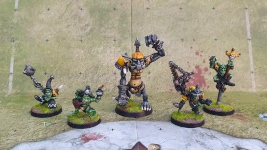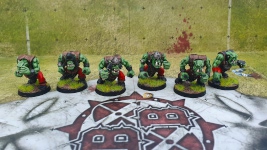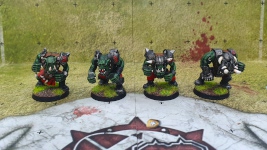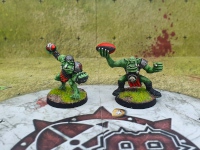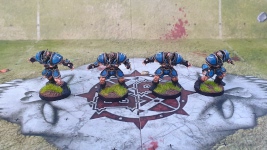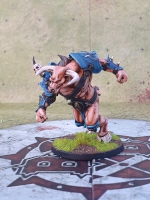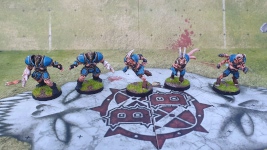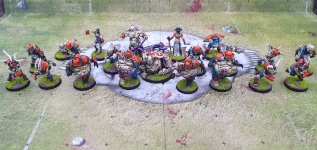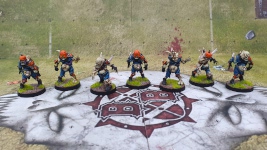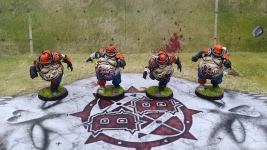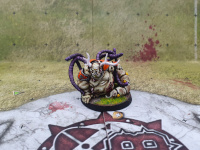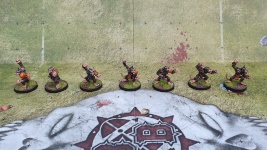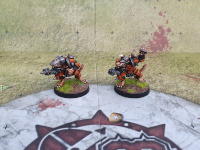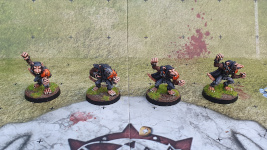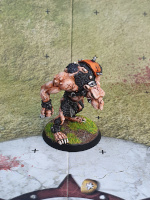Way back in 1988, Games Workshop released a game called Adeptus Titanicus. It was set in GW’s Warhammer 40,000 setting (which was only a few years old at that point), but rather than being set in the ‘present day’ of the setting, it was set in a ‘historical’ period, during a civil war called the Horus Heresy. The game featured giant robots fighting each other and so as to avoid having to fully detail multiple factions the civil war story was concocted to explain why the robots on each side were all essentially the same. Initially the game included only one type of robot, the Warlord Titan. Since there weren’t any other models for these ‘warlord titans’ to be compared with, it didn’t matter very much exactly how big they were. They were definitely huge, but how huge was left fairly ambiguous. As the model range expanded to include other, smaller Titans, as well as similar war engines produced by other factions in the setting, the relative sizes of different war engines started to be established, but how large they were compared with — for example — people remained ambiguous.
GW soon expanded its new ‘Epic’ game system to include infantry and armoured vehicles, releasing rules for them in a second game, compatible with the first, called Space Marine. This forced GW to pin down a scale for the game, at least to some extent. GW loosely adopted a 6mm (1/285) scale, but honestly they were never very consistent about the scale of their models. In particular, the Titans that had started the game off often had details such as small doors and hatches that suggested that they should be much bigger relative to the infantry than the models actually were. The background and artwork also tended to depict them as bigger, although how much bigger varied. Nonetheless, although later redesigns of the titan models were slightly bigger than the originals had been, they retained broadly speaking the same (small) scale throughout the lifetime of GW’s Epic scale games as it went through various editions, before GW finally abandoned Epic nearly a decade ago.
It was towards the end of this era, in 2010, that I put together an army of Titans for Epic. Most of the models that I used in that army are the ones that were originally released for Adeptus Titanicus in 1988-89. At that point it was fairly clear that they were somewhat undersized but all of the titan models available for Epic were still this size, so that was the best any of us could do. At the time it was my intention that as well as forming an army in their own right, I could also use the models alongside the Space Marine and Imperial Guard armies that I hoped I would go on to paint.
However, before I could make a start on those armies, there were some developments that forced a re-think. Firstly, Forge World, GW’s resin-casting offshoot, started producing titan models for Warhammer 40,000. This meant that at last there was a consistent, official source on just how big these war engines were supposed to be. And they were, as everyone pretty well knew already, quite a lot bigger than their Epic models suggested.
Secondly, the golden age of what became known as ‘forumware’ began. As GW gave up producing models for Epic, hobbyists stepped up to fill the gap. Using CAD software and 3D printing technology, several members of the Epic community started producing Epic-scaled models based on GW’s W40k designs and covertly sharing them with other gamers via online forums (hence ‘forumware’). And among the models that became available at this time were new ‘true-scale’ titan models.
Exactly what constitutes ‘true scale’ in Epic has long been open to debate. The only time GW made a serious attempt at a consistent scale was when Forge World produced resin vehicles and infantry, which they scaled to 1/5 of their W40k equivalents. With W40k itself being quite sloppy and inconsistent about scale, this was a far-from-perfect solution, but it did at least provide some basis for a ‘correct’ size for titans.
I was lucky enough to get hold of some of these new models myself, but I confess I still wasn’t completely sold until I started work on my Space Marines. What really swung me was the transport aircraft. I used two Thunderhawk Gunships from Forge World in my army and they used FW’s 1:5 scaling ratio. Consequently they were huge, and my old small-scale Warhound Titans were clearly much too small next to them. My new truescale forumware Warhounds, by contrast, were appropriately large, so alongside my Space Marines I painted up a pair of truescale Warhounds, using the same colour scheme that I had used for my original AMTL army. Shortly after finishing the Marines (an army that also included a significant amount of forumware), I added a Reaver titan, one of the last things I painted before taking an unplanned break from painting for a while.
There was a snag, however. Although I had a Reaver and a pair of Warhounds, I had no truescale Warlord to go with them. There had been a significant delay between Forge World releasing their W40k Reaver and the Warlord model, and by the time the latter existed, the sculptor of my other Titans had given up producing forumware altogether. Fan-made models did appear, but I was never able to establish exactly who was producing them. I believe their creator was Australian, but that was as close as I got.
And there the story might have ended, had I not bought myself a resin 3D printer back in October last year. Finally I was no longer dependent on forumware producers to make truescale titans for me; I could print my own! I already had a set of files; all I had to do was print them.
So at last I have a full set of truescale Mars-pattern Imperial titans. It took a few months before I got around to actually painting the Warlord, but now it is done.
So first of all, here are the Warhounds:
And here’s the Reaver. The 40k model doesn’t have an option for Turbolaser Destructors as arm weapons, and consequently neither does this one. However, that is the standard weapons configuration for Reavers supporting Space Marine or Imperial Guard armies in Epic, so I used the spare TLDs that came with the Warhounds and adapted them to fit on the Reaver.
Finally, painted more than four years after the Reaver, here’s the Warlord. Again, I had to make some adjustments to get the standard weapons configuration, as the files I had only included a pair of Volcano Cannons for the arms and a pair of Laser Blasters for the carapace. A Gatling Blaster for the arm wasn’t too hard to find, but I couldn’t find any suitable TLDs, so in the end I had to make my own by re-mixing a few other files and mashing them together. I’m pretty happy with the result.
Finally, here’s a group shot of all four titans together, along with a few Space Marine units for scale:
So that’s it for Imperial Titans. But now that my Imperial Titans are so much bigger than the old ones, what about my other armies? My AMTL army I intend to leave as it is, at least for now. Refreshing a few models is one thing, but I don’t particularly want to go back and re-do an entire 10,000-point army just at the moment. My Chaos titans, however, I am in the process of revising. I have managed to acquire files for Warhound, Reaver and Warlord titans in the same ‘Lucius-pattern’ style as the models I originally used for my Chaos Titans, and have set about creating new truescale models. I have added chaotic features partly by re-mixing the files and partly by more traditional conversions with modelling putty and metal parts as well as 3D prints. So far only the Ravager (Chaos Reaver) is painted; once the others are done I will post them here.
Eldar are a little trickier. I am not entirely happy with the files I have for any of the Eldar titans but I may still be able to get hold of some forumware models that I think will do very nicely. Failing that, there are some very nice digital sculpts available, so I should be able to come up with something that works.
3D printing has also allowed me to put together new armies. I already had some Imperial Guard that I was intending to paint eventually, including a mix of original GW models, old Forumware, and some proxies from Trolls Under the Bridge and Vanguard Miniatures. With my printer I’ve been able to expand this force considerably as well as replacing most of the proxies and forumware. This army is now approximately 50% painted and I expect to get more done over the next few weeks. Meanwhile I have already started printing out models for Tyranid and Tau armies. And I hope to revise and expand the small Ork army that is still waiting to be painted, in the same way as I have my IG.
The one thing that has fallen by the wayside, however, is Blood Bowl. I never did paint up any of the Elf players that I was planning. It may yet be some time before I return to 28mm painting, although I hope to do so eventually.
